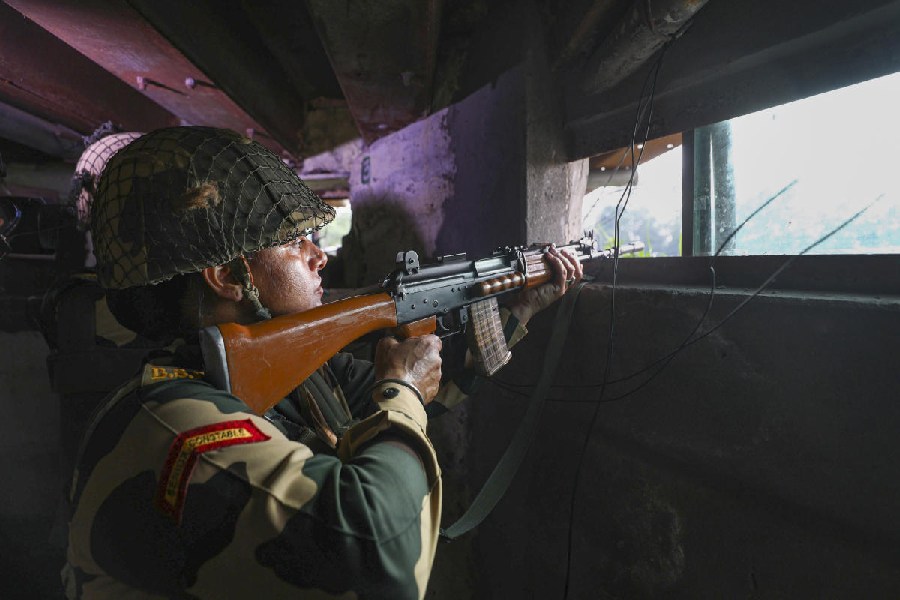

Did Harry Houdini ever visit Bamanpukur in Nadia? The question may, understandably, arouse a sense of incredulity. But the connection between Houdini and a nearly-forgotten speck in Nadia may not be that tenuous. One of Houdini's famed tricks was known as the "Vanishing Elephant": the illusion was first performed in New York's Hippodrome Theatre almost one hundred years ago.
Something has vanished in Bamanpukur too. Or so asserted the Union culture minister, Mahesh Sharma, a few months ago. Of the "24 protected monuments" that have disappeared in the country in the recent past, one, Sharma said, was a "fort" in Bamanpukur. After reading Sharma's revelation, I had made up my mind to travel to Bamanpukur to trace the history of the fort's disappearance. I had hoped to find traces of, if not the fort then at least, Houdini's sojourn to Nadia.
Imagine my disappointment when I realised that Houdini had not set foot in Bamanpukur - courtesy a letter.
The note from the superintendent archaeologist from the Archaeological Survey of India's Calcutta circle confirmed my fears. As is a journalist's wont, I had sniffed around a bit and dug up a few sources before travelling to Bamanpukur. One of them had put me in touch with the superintendent archaeologist, a kind and industrious soul, who, in turn, did a bit of research and then sent me the information that ended my Houdini fantasy. Mind you, the emailed documents - they were scanned copies of the original - were quite interesting, even though one of them led to heartbreak.
"The Ruins of Fort at Bamanpukur, Dist. Nadia," it said, "was declared as a monument of National Importance" by a gazette notification in 1920. Seven years later, yet another gazette notification had "changed the name of the site as 'Ancient Mound known as Bamanpukur Mound or fort'". "The Ruins of Fort," continued the letter, and the "Ancient Mound known as Bamanpukur Mound or fort" is, thus, the same structure.
Houdini had vanished from the plot. But not my fascination with the ruins of the Mound. Before setting out, the district correspondent helped me excavate yet another source. Apparently, Sanjit Datta, trained as a librarian but in love with Nadia's history, is the man to turn to if one were to go to Bamanpukur. A call was made, a date fixed, and a train - the Krishnanagar local - boarded. Once the train reached Krishnanagar I realised why Houdini had given Bamanpukur the slip. The pollution made my eyes water. At the station, a toto driven by a teary-eyed man ingested its teary-eyed passengers, including me, and then spat us out near a bus stand. The bus ride to Dhubulia was followed by yet another toto journey, past the villages of Rajapur and Satpukur, to, finally, Bamanpukur.
A remarkable transformation took place in Sanjit once we reached the Mound, a spectacular brick structure that stood, defiant of time, on a raised patch of land. While lecturing me passionately about the Mound's history - the ruins are associated with King Ballal Sena of the Sena dynasty and excavations had brought up, among other artefacts, human and animal figurines as well as copper utensils - Sanjit photographed the site and took careful notes of the passages and its geometric alignments. He resembled a sleuth on an ancient, but still warm, scent. His engagement was a clear reminder of history's hold on the mind.
The enchantment with history, I learnt that day, can transcend the borders of class and education. One of the sentinels of the Mound, the caretaker, who'd been indifferent to the rich legacies hidden in the nooks and corners of the country, now has a voracious appetite to learn about historic monuments. The man, who, seemingly, occupies the lowest rank in the hierarchy of the ASI, even had valuable suggestions to make the experience of visiting Bamanpukur enriching. Boards with better signage, interactive tours with knowledgeable guides, booklets enlisting information on the Mound and a small museum, he said, could kindle public interest in such heritage monuments.
Sanjit and the official who cannot be named have the potential to serve as the metaphorical bridge to connect a people to their history. But the odds the duo face are considerable. Regional sites such as Bamanpukur are largely ignored by the school curriculum. Then there is the pervasive institutional apathy: that conservation requires a steady flow of funds and state-of-the-art infrastructure continues to elude the authorities. There is also the usual bureaucratic lethargy to link tourism with local, as opposed to national, heritage. Ironically, Bamanpukur lies close to a well-travelled tourist route. The Isckon complex, with its vast and garish temples in Nabadwip, is not distant.
But the most formidable of the obstacles seems to be the disinterest in the community to explore local history. The only other visitors I encountered during the afternoon was an amorous couple who photographed not the Mound but themselves. On asking a local resident what the "Ballal Dhipi" meant to her, she replied, without much thought, that the grass on the Mound was excellent fodder for her goats. The lack of a collective engagement has damaged the site, quite literally. I was told that one of the figurines, that of a makar-mukh, had been disfigured by a cracker.
On our way back, we took a boat over the murky Jalangi and reached Mayapur. Walking past the maths and the crowded stalls, I could not help but think of the relatively quiet Mound. Thousands were visiting Mayapur that day. Around the same time, Bamanpukur had received only a handful of visitors: two lovers, one inquisitive researcher and a pesky journalist.










